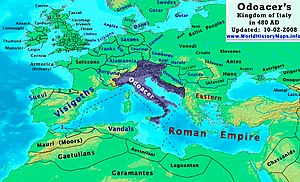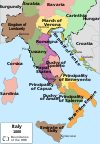Odoacer: Difference between revisions
Chesslover96 (talk | contribs) No edit summary |
added king of italy list |
||
| Line 39: | Line 39: | ||
{{s-aft|after=[[Theodoric the Great]]}} |
{{s-aft|after=[[Theodoric the Great]]}} |
||
{{end}} |
{{end}} |
||
{{Antique Kings of Italy}} |
|||
[[Category:Ancient Germanic people]] |
[[Category:Ancient Germanic people]] |
||
Revision as of 05:47, 4 April 2008

Odoacer (435 – 493), also known as Odovacar (from the Germanic Audawakrs, meaning "watchful of wealth"), was a Roman general and the first barbarian King of Italy, who deposed the Western Roman Emperor Romulus Augustus in 476.[1]
Early life
Odoacer was probably the son of the Scirian chieftain Edeko, who was a Germanic vassal chieftain at the court of Attila. All the Germanic vassals of the Huns broke free the Battle of Nedao in 454, where the Germanic vassals (Gepids, Ostrogoths, Scirians, Herules and Rugians) unleashed a minor defeat against the Huns and Alans. After this battle, the Scirians split up. Parts joined the Visigoths, other parts joined the Ostrogoths and the rest of the Scirians united with a part of the Herules and became foederati of the Western Roman Empire. The foederati were sent to Gaul. Odoacer was a slave in the foederati, but as the son of Edeko, he always remained a nobleman among the Scirians. The foederati were pulled out of Gaul and sent to Italy by Ricimer under the rule of Anthemius in 466.
Leader of the foederati

In 470, Odoacer was appointed leader of the foederati. In 475, Orestes was appointed Magister militum and patrician by the Western Roman Emperor Julius Nepos; he was therefore made head of the Germanic foederati of Italy (the Scirian - Herulic foederati). Orestes promised them a third of the Italic peninsula if they led the revolt against Emperor Nepos. The foederati were 30,000 strong (plus families), and they had lived on the Italic peninsula for several years at this point; however, they had only received scraps of land in relatively unfertile areas around the Apennine mountains. The foederati accepted the offer and led the revolt as planned; on August 28, 475 they defeated Nepos, who fled to Dalmatia. With the emperor far away, Orestes elevated his son Romulus to the rank of Augustus, so that the last Western Roman Emperor is known as Romulus Augustus.
After the revolt, Orestes, as magister militum, organised his own army. Behind the safety of his army, Orestes rescinded his pledge to the foederati; as a result, the foederati revolted and defeated Orestes. Odoacer was the leader of the revolt against Orestes, who was captured and executed. After the revolt, the Germanic foederati, the Scirians and the Herules, as well as a large segment of the Italic Roman army, proclaimed Odoacer rex Italiae ("king of Italy"). In 476, Odoacer advanced to Ravenna, capturing the city and the young emperor. Romulus was compelled to abdicate on September 4, 476. In the same year Odoacer renounced the meaningless title of Emperor, which was a wise move that avoided a conflict with Constantinople. He sent the imperial insignia to the Eastern Emperor Zeno and declared himself Patrician of the Western Half (which, by this time, was no more than the Italian peninsula). Odoacer was then confirmed as rex Italiae by Zeno later in 476. The rightful Western Roman Emperor Julius Nepos remained powerless in exile in Dalmatia, where he would continue to reign until his assassination in 480.
King of Italy

In 476, Odoacer officially became the first Germanic King of Italy and a new era began. Odoacer was an Arian Christian and is said to have been illiterate. The warriors and the families in Odoacer's foederati received lands in Italy and became beneficiaries of a special tax policy. Odoacer retained the Roman administration, senate, law and tax system of Italy intact. In return, he won a high level of support from the senate and people.
Odoacer raised an Italic-Germanic army with which he defeated the Vandals in Sicily. He was able to conquer the whole island by 477. In 480, he and his Italic-Germanic army conquered all of ancient Dalmatia, after the death (assassination?) of Western Emperor Julius Nepos. After this, he received the right to appoint a council and to issue his own coinage. He made pacts with the Visigoths and Franks and joined them in battle against the Burgundians, Alamanni, and Saxons.
As Odoacer's kingdom expanded, his popularity among the Italic people grew, and his pacts with the Franks and Visigoths gave him increased influence. All these things started to worry Zeno, the Eastern Emperor, who increasingly saw Odoacer as a rival. In 487 Odoacer led his army to victory against the Rugians in Noricum, but he did not incorporate it into his own kingdom. The remaining Rugians fled and took refuge with the Ostrogoths. Rugiland was left open and by 493 was settled by the Lombards. In 488, Emperor Zeno started a mostly verbal campaign against Odoacer, accusing him of playing a major part in the revolt of Illus in 484. With these claims, Zeno convinced his Ostrogothic vassals that Odoacer was an enemy and should be removed. Zeno promised Theodoric son of Amal and his Ostrogoths the Italic peninsula if they were to defeat and remove Odoacer. In the same year, 488, Theodoric led the Ostrogoths across the Julian Alps and into Italy. The accusation that Odoacer was part of the Illus revolt was a lie, fabricated by Byzantine noblemen, generals, and Zeno who wanted the now mighty Odoacer removed.[citation needed] With this scenario, the Byzantines killed two birds with one stone. They removed the Ostrogoths from the Balkans and their border and at the same time conveniently caused Odoacer to disappear from the scene.
Death
Theodoric and his Ostrogoths defeated Odoacer at Aquileia in 488, at Verona in 489, and at the Adda River in 490. In that same year, Theodoric besieged Odoacer at Ravenna. The siege lasted three years and was marked by dozens of attacks on both sides. This massive siege is known as the Battle for Ravenna. In the end, neither side won this battle. On February 2, 493, Theodoric and Odoacer signed a treaty that assured both parties would rule over Italy. A banquet was organised in order to celebrate this treaty. It was at this banquet that Theodoric, after making a toast, killed Odoacer with his own hands.
Theoderic became the new king of Italy and established an Ostrogothic kingdom that was ruled from Ravenna. The remainder of Odoacer's foederati joined the Ostrogoths and were allowed to remain in Italy. Many of the fathers of these warriors and a number of the warriors themselves had fought together with the Ostrogoths at the Battle of Nedao in 454.
The events around the Battle of Ravenna were used in the Germanic heroic saga of Dietrich von Bern (Theodoric of Verona). The event in which Theodoric kills Odoacer with his own hands is mirrored in the saga in the episode in which Dietrich kills the Dwarf King Laurin.
Notes
Sources
- Articles needing cleanup from February 2008
- Cleanup tagged articles without a reason field from February 2008
- Wikipedia pages needing cleanup from February 2008
- Articles lacking sources from October 2006
- Ancient Germanic people
- Arian Christians
- Mercenaries
- Roman patricians
- 435 births
- 493 deaths
- Magistri militum

